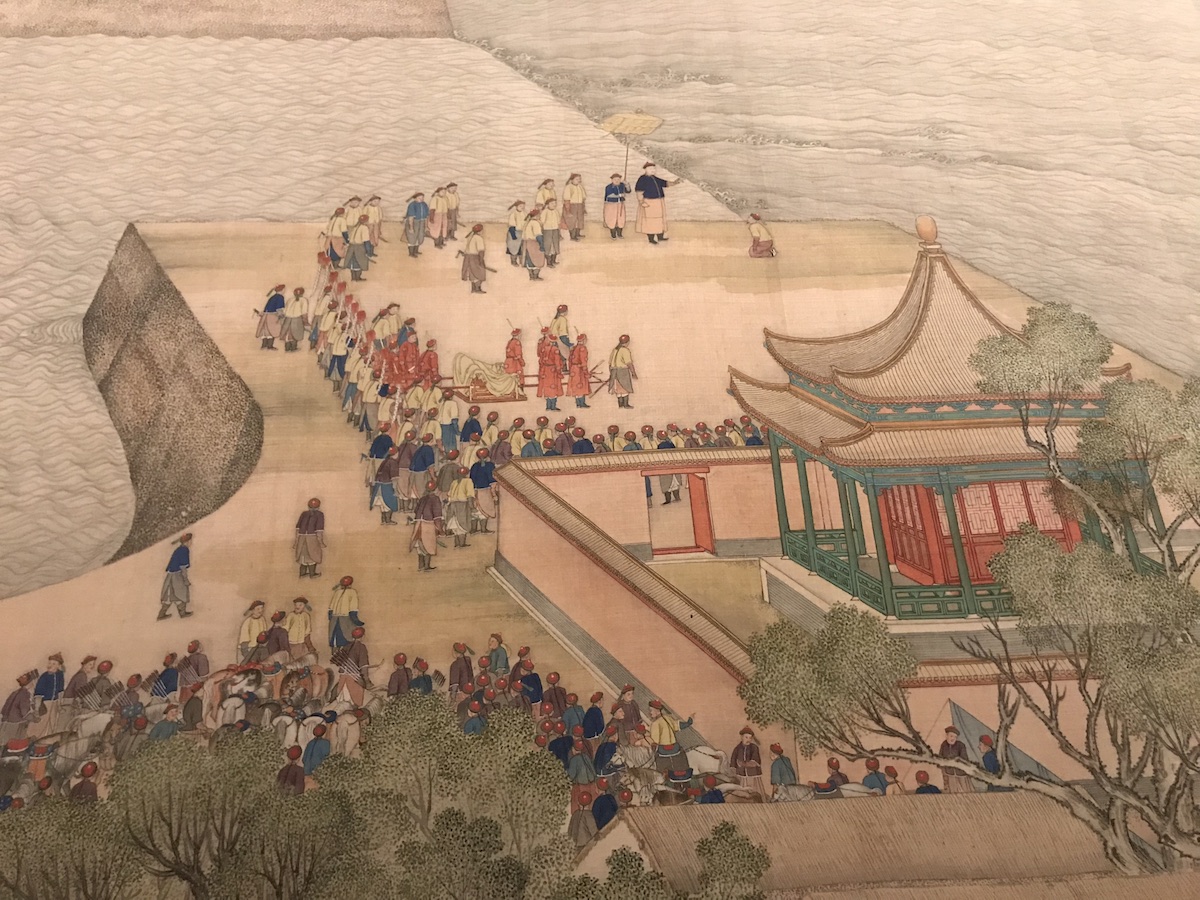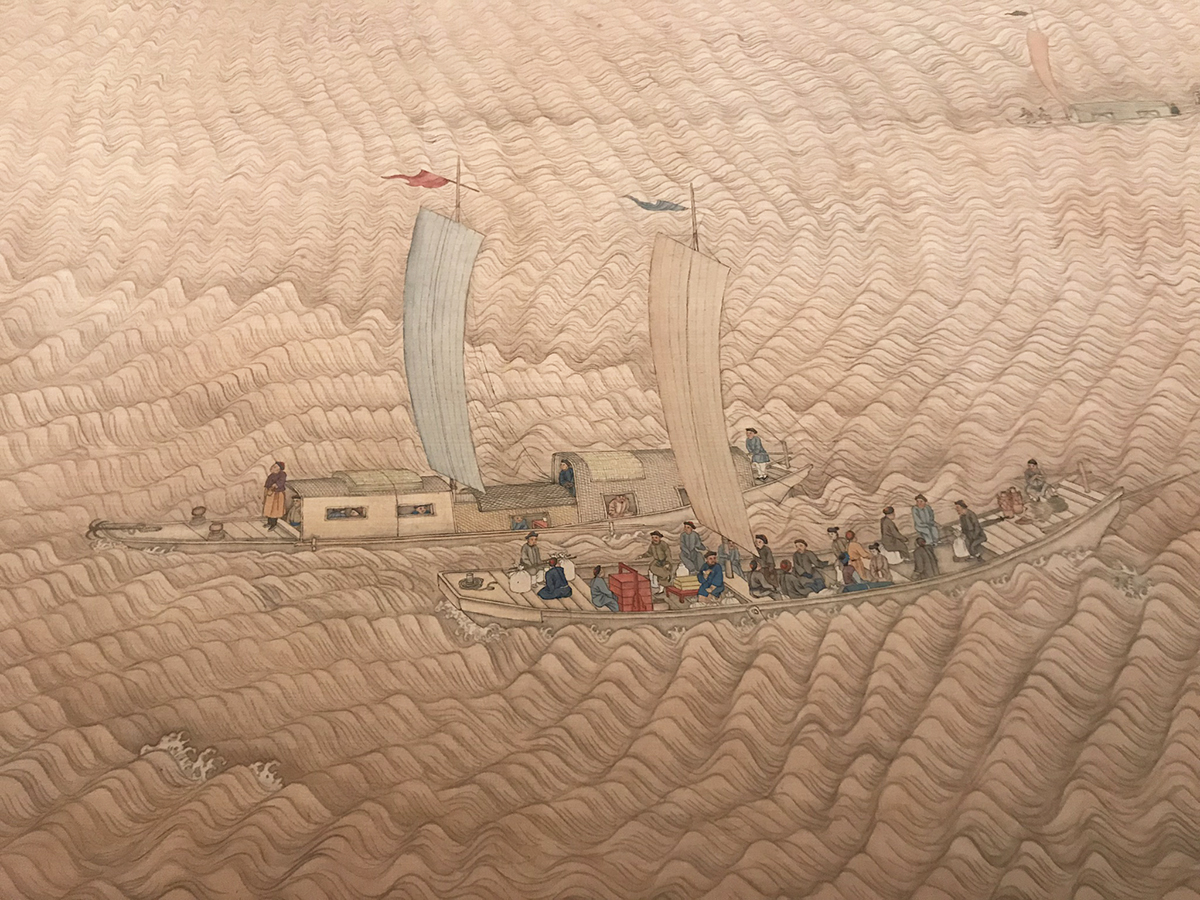
Towards the end of the Ming Dynasty (1368-1644), widespread famine, disease, and poverty prompted many of China’s citizens to riot. Meanwhile, in the northeastern region of Manchuria, an ambitious Jurchen leader named Nurhaci had been amassing power. By 1621, he already controlled the region surrounding Shanhai Pass, a pivotal location along the Great Wall. When his son Hong Taiji took over in 1635, he formally changed the name of his people from the Jurchens to the Manchu. In the following year, Hong established the Qing Dynasty and encouraged discontented Han Chinese people to defect. Many of them joined his military force, which was known as the Eight Banners[1]. Over time, this military system would grow to become the main organizational and social framework of the Qing Dynasty.
The situation reached a critical point in 1644, when a rebel leader named Li Zicheng captured the imperial capital of Beijing and the last Ming emperor committed suicide, thus marking the end of the Ming Dynasty. Li then sent an army to confront the Ming commander Wu Sangui, who was stationed at Shanhai Pass. With Li’s troops on their way and the Manchu army at his back, Wu had to think fast! Since he had served on the Great Wall for so long, he had become familiar with his northern enemies, the Manchu. In the end, he decided to choose the devil he knew! Wu formed an alliance with the Manchu and allowed them through the gates of Shanhai Pass. In the same year, they conquered Beijing from Li and Hong Taiji’s son took the throne as the Shunzhi Emperor.
At the time of his ascension, Shunzhi was only five years old and relied heavily on the help of his uncle, Dorgon. Instead of sacking Beijing, Dorgon insisted that it also be made the Qing capital and reappointed many of the old Ming officials into government positions. His expert political manoeuvring helped to quickly stabilise the regime and meant the Qing could conquer the rest of China much faster. Unfortunately, Dorgon died during a hunting expedition in 1650, and Shunzhi was suddenly left to rule the country alone. His reign appeared to be promising, but tragedy was waiting just around the corner!
In 1661, at the age of 24, his life was cut short when he unexpectedly died from smallpox. He was succeeded by his third son, who was named the Kangxi Emperor. Kangxi took the throne at the age of 7 and didn’t pass away until he was 68, making him the longest-reigning emperor in Chinese history, after having served for a staggering 61 years! He became known as one of the Qing Dynasty’s most competent rulers. During his reign, the dynasty reached its zenith in terms of cultural, economic, and military accomplishment.
This period of prosperity lasted through the reigns of his son, the Yongzheng Emperor, and his grandson, the Qianlong Emperor. However, as the old saying goes, all good things must come to an end! Qianlong was particularly famous for his patronage of the arts and funded the Siku Quanshu or “Complete Library of the Four Treasuries”, an invaluable anthology of over 3,400 books. Unfortunately, he also squandered enormous sums of money on a series of military expeditions known as the Ten Great Campaigns, which increased Qing control in Central Asia but nearly bankrupted the imperial treasury in the process.

in MET, New York
Under his reign, the population rose to an impressive 400 million but, since he had fixed the taxes at a low rate, an economic crash was inevitable. Available farmland became scarce, and soon peasants were forced to farm increasingly smaller and over-worked plots. Court factionalism intensified and an imperial favourite named Heshen, now regarded as one of the most corrupt political figures in Chinese history, became dangerously powerful.
When Qianlong’s son, the Jiaqing Emperor, took the throne in 1796, he was handed a significantly weaker empire than the one his father had received. During the first year of his reign, a violent revolt known as the White Lotus Rebellion broke out and continued for eight long years, until 1804. Meanwhile, the European empires were gradually expanding across the world, and their economies were becoming increasingly dependent on maritime trade. The Canton System, which restricted maritime trade to the city of Guangzhou and gave monopoly trading rights to Chinese merchants, was beginning to cause tension between China and other foreign powers.
The issue was further compounded by the fact that China’s economy was reasonably self-sufficient. Since China had no need to import goods, Britain and France were forced to use their increasingly limited supply of silver to purchase much-desired Chinese goods such as silk, tea, and porcelain. However, Britain finally hit upon a very addictive solution! One thing the Chinese craved, and in large quantities, was opium. In response to growing Chinese demand, the British East India Company expanded its production of opium in Bengal.
When the Daoguang Emperor succeeded his father Jiaqing in 1820, he became deeply concerned about the outflow of silver spent on opium and the damage that opium smoking was inflicting on his subjects. He ordered his official Lin Zexu to end the opium trade and, in 1839, Lin confiscated large quantities of British opium without compensation. In the following year, Britain responded by sending a military expedition to China, which led to the First Opium War (1839-1842).
While the Qing Dynasty had remained set in their traditional ways, the British government had embraced technological advancement. The Qing navy, composed entirely of wooden sailing junks, was easily outmanoeuvred by the modern ships of the British Royal Navy. British soldiers, who wielded advanced artillery, outgunned Qing forces on the ground. In 1842, the Qing court was forced to surrender, which dealt a humiliating blow to the once proud regime.
Daoguang was made to sign the Treaty of Nanking, which dictated that China must pay war reparations, open up five treaty ports (Guangzhou, Xiamen, Fuzhou, Ningbo, and Shanghai) to foreign trade, and grant Britain control of Hong Kong. In 1844, this unequal treaty was followed by the Treaty of Wanghia with the United States and the Treaty of Whampoa with France, both of which granted a myriad of privileges to the foreign nations.
Although these treaties helped to ease the tension between China and its foreign neighbours, it by no means solved the problem. Guangzhou was declared open to foreigners in 1843, but the British faced extreme opposition from the native Cantonese. This anti-foreign movement swept across the province of Guangdong, and in turn prompted a strong anti-government sentiment amongst the people, as they believed the Qing court had failed to keep the “foreign barbarians” out of the country.
This strained environment finally culminated in the Arrow incident. In 1856, Guangzhou police seized a British-registered ship called the Arrow and charged its crew with piracy and smuggling, which prompted the British government to send a fleet to Guangzhou. France also sent military forces in support of its ally. Towards the end of 1857, Anglo-French forces occupied Guangzhou and the Second Opium War (1857-1860) officially began.
In 1860, allied forces invaded Beijing and the reigning Xianfeng Emperor was forced to flee. By the end of that year, the Qing had suffered another humiliating defeat and the Emperor had to sign additional unequal treaties, which allowed foreign diplomats to live in Beijing and granted Christian missionaries the freedom to evangelise their faith. After conceding so much to foreign powers, the prestige of the Qing Dynasty was at an all-time low.
Note:
[1] The Eight Banners: When the Qing Dynasty first began, the Eight Banners was simply a military system that was used to unite and mobilise the Manchu people. Only Manchu people could be part of the Eight Banners, but the Mongolian Eight Banners was formed for Mongolians and likewise the Han Eight Banners for Han Chinese people. Over time, it evolved from a military system into the basic organisational framework that came to define Manchu and Qing society.